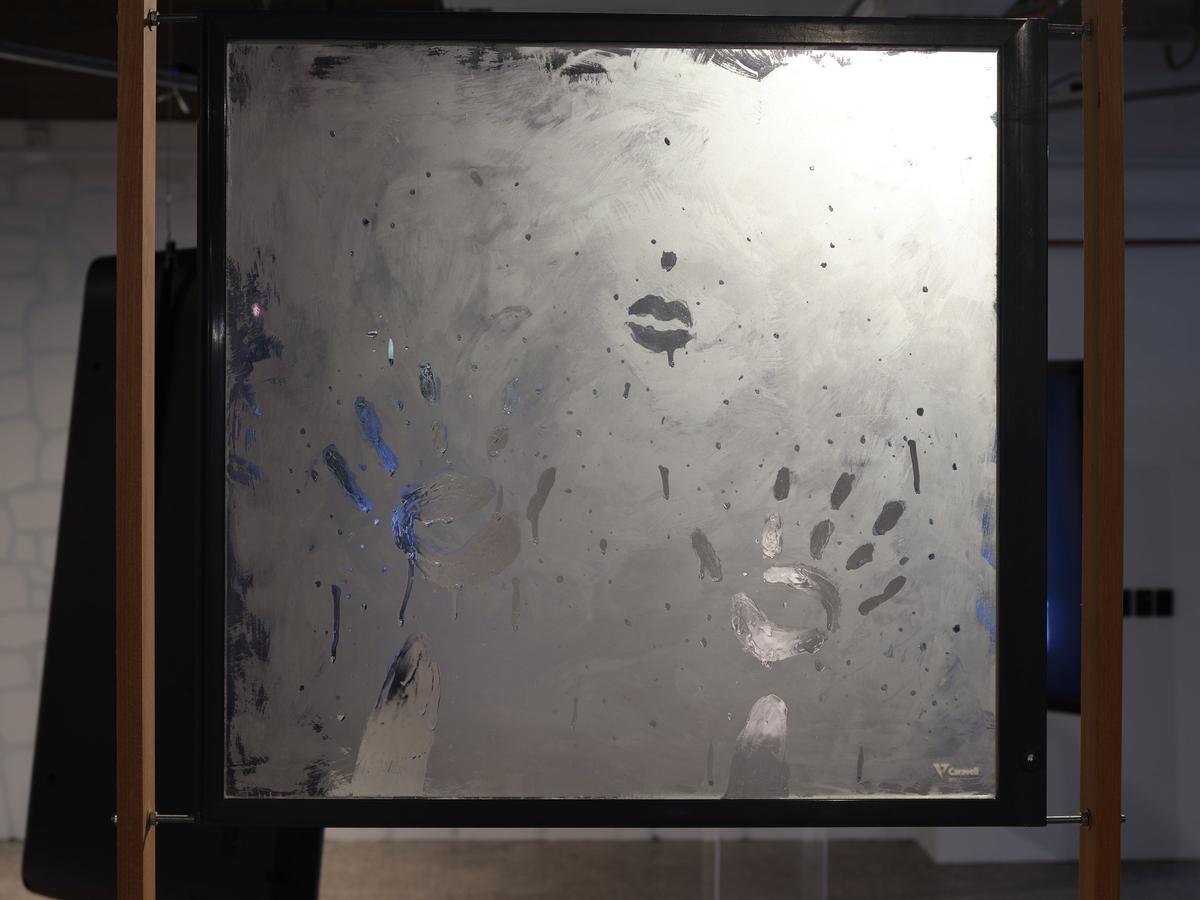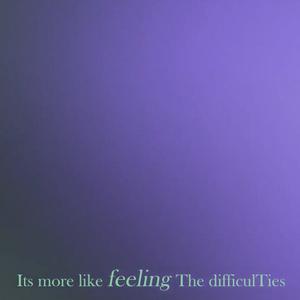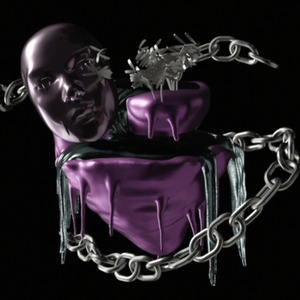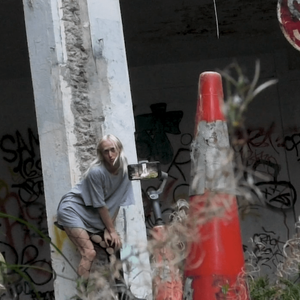CRUEL OPTIMISM, Artspace Aotearoa’s 2021 new artists show, had the inauspiciousness of being scheduled during a lockdown. This seems fitting, having taken its collaborative title and curatorial chutzpah from Lauren Berlant’s book of the same name. For those who haven’t read it, the book explores the cruelty inherent to broad promises of prosperity in a system that privileges existing networks of patronage and parentage, advocating accessibility while catering exclusively to an elite. Though, as the show’s seven artists insist, within the disillusionment of being handed empty plates at an alleged feast, there’s an optimal chance for emancipation from all the strictures (psychological and material) that neoliberal prosperity entails—regardless of whether you’re living kingly at its centre, or digging through scraps on the periphery.
The pandemic shows exactly how ubiquitous the cruel optimism of contemporary society is, as relief and vaccines are rolled out with disproportionate ease to those less affected (cushioned by generationally entrenched resources), while the existing precariousness of others finds an abject amplification. If anything, it’s been a telling diagnostic of where infrastructural priorities lie, and where those born outside inheritances of status and wealth truly stand in relation to a collective performance of equity which is exactly that—a performance. Though cultural theorist Slavoj Žižek speculates the importance of even theatrical democracy—in as much as it rarely delivers on its promise of universal representation but remains necessary to keep fascistic alternatives at bay—CRUEL OPTIMISM seems to strenuously rebut the notion of top-down handholding, and wonders at full volume: is there really no other dyad of incentives between the carrot and the stick?
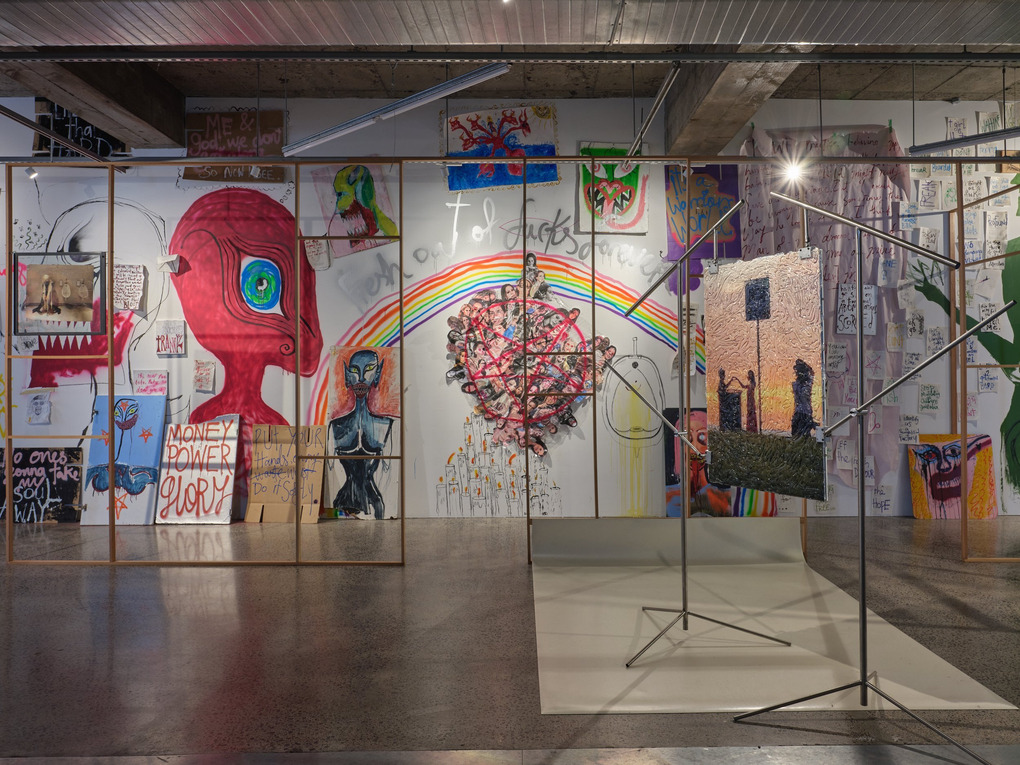
Background: faith devours hope (2021) tsAPEXALTERNATIVECONCUBINE; foreground: Fool's Paradise (2021) Obadiah Russon. Photo: Sam Hartnett
APEXALTERNATIVECONCUBINE’s work faith devours hope (2021) traverses an entire wall-section of the gallery, exhuming and displaying what feels like the livid process of being sutured by optimism and fatalism in equal measure. Like with this artist’s participation in RM Gallery’s group show The Killing, which saw vibrant collaboration between gender-diverse artists decking the walls in rainbow-vitriol, CONCUBINE has smeared themselves—sometimes literally—in a series of sketches, paintings, and collage, in a brusque and polemical dada-like mural. The eclecticism is dizzying. Its deliberately scrappy elements interrogate the artistic necessity of finesse and in its strongest moments, more than compensates for this absent "finery" (for imagined naysayers) with spectacle and bombast. It bears spending time with too. From one wall to the other and back again, the detail here is impressive, the scope going from fist-pumping against the evils of the crown (configured like the diary missives of an enraged adolescent), to a satanism-couched Lana Del Ray shrine (as far as I can see, a labour of love), to a host of golems like something out of Neil Gaiman’s Sandman (1989-) pantheon.
Russon’s work overtly acts as most screens do, these glassy interfaces which intimately manage all of our affairs—as impossible (miraculous?) windows. Windows onto what?
Obadiah Russon’s work has a modern-conceptual mysticism that makes you want to touch it, and yet approaching their structures you get the sense they might evaporate before you even could, or, worse still, latch on to you like vaporous curses. With a deceptive banality, Russon’s photographic-sculpture-work Fool’s Paradise (2021) is perhaps most crucially about haunting. Without drawing too heavily on the specific schematics of Mark Fisher’s hauntology (Ghosts of my Life: Writings on Depression, Hauntology and Lost Futures, 2014), the notion of renegade affects haunting contemporary obsessions with non-contradiction (especially concerning gendered identity) is here—this idea that self-same identity signifiers are inherently cathected by their designated other, that desire and repulsion are tics belonging to the same subjective manoeuvre. Or, that identity-formation must move through what it is not before determining what it is. Cleverly using resin and glass to evoke steamy touch through, say, a glass shower cubicle, Russon’s simulated impressions orbit notions of that which lingers, the trace that uncannily endures beyond ephemeral encounters. In this vein, Russon’s work overtly acts as most screens do, these glassy interfaces which intimately manage all of our affairs—as impossible (miraculous?) windows. Windows onto what? This query seems to underpin Russon’s work here, and as queries go it’s a quietly exhilarating one.
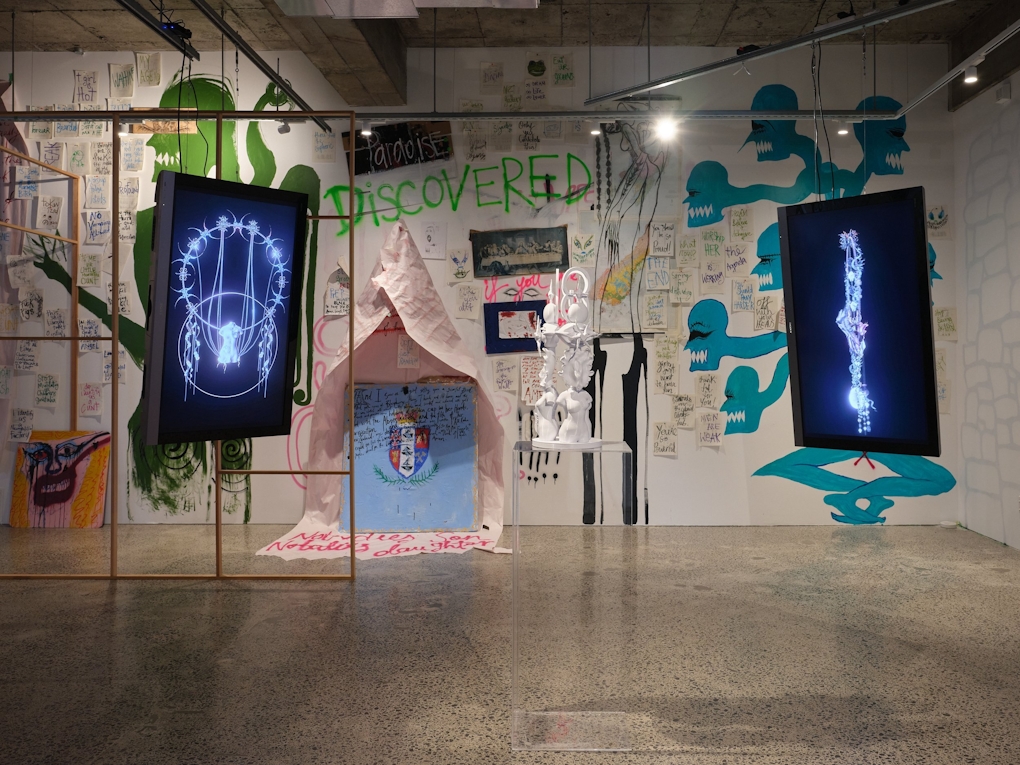
Installation view, l-r: The idol worship of cynic (2021); The grotesque of consumer symbols (2021); Aggregate of desires (2021) Xi Li. Photo: Sam Hartnett
In direct rebuttal to the exhilarating messes of CONCUBINE is Xi Li, whose digital and material sculpture work proffers an almost aggressive symmetry, a beauty as starkly synthetic as it is vaguely ritualistic. In its placement, Li’s work tethers CONCUBINE's and Russon’s, a mattered segue speaking perhaps to the metaphysical import of beauty as a consumerist affect, and how the perfect object, while myth, still categorically dominates, as the best myths do. The ring of screens showing the works Ritual of Subject, The flattering of physical changes, The anti-enjoyment mentality of abstinence, The grotesque of consumer symbols, and The idol worship of cynic (all 2021) point to the material realisation at their centre, Aggregate of desires (2021), which religiously gathers each flat-but-sparkling speculation into a monolith of defiant perfection—like stained-glass tableaus round a Vatican relic. Tellingly, this monolith has certain labial details, perhaps a rumination on the gendered nature of this impossible hyper-object behind consumerist fancies, and how feminine bodies are recruited (hijacked?) as satellites in a confounding well of affective mythologising—and perhaps, in its mathematical proportions, a description of consumerist desire as running cold, not hot. An algorithm, not a combustion.
Anto Yeldezian’s painting taps into existing traditions while filtering figures through a pearly-pastel fun-house mirror, grafting traditional techniques with shellac-chromatics and an uncanny flatness—this flatness only amplifying the surreal elements of the artist’s work. In Pantheon Picnic (2021) Yeldezian depicts a gathering of godly figures whose bodies are swollen with sunset palettes against russet blue, figures as haloed as they are dysmorphic. They bleed into one another, and in the absence of rendered food one wonders if the titular picnic is actually a cannibal’s bazar. Or perhaps the gods will feast on us, their children, fit to burst through the dimensional-membrane of the painting itself and run amok. Coloured with the close of day, is it our world seeing a timely demise with Yeldezian’s pantheon fixing to pick its bones in apocalyptic blazes? Perhaps.
Tellingly, this monolith has certain labial details, perhaps a rumination on the gendered nature of this impossible hyper-object behind consumerist fancies, and how feminine bodies are recruited (hijacked?) as satellites in a confounding well of affective mythologising—and perhaps, in its mathematical proportions, a description of consumerist desire as running cold, not hot.
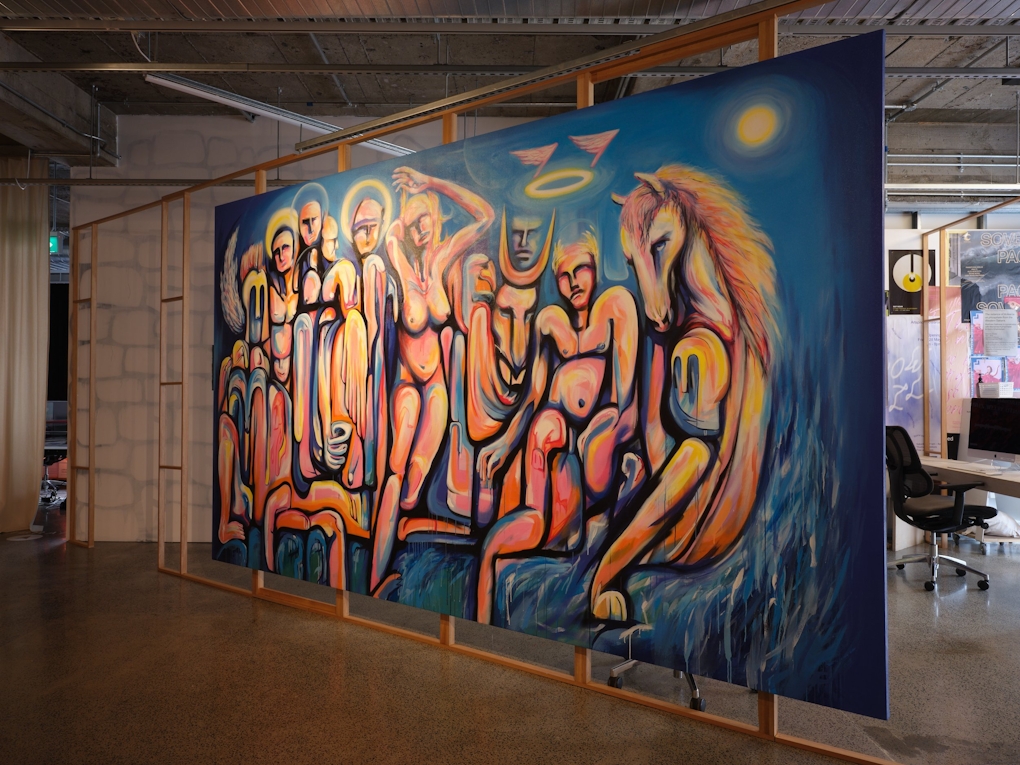
Installation view of Pantheon Panic (2021) Anto Yeldezian. Photo: Sam Hartnett
On the back of Picnic is Yeldezian’s Eden Race (2021), featuring another vaguely eschatological herald: an unholy hybrid of swan swivel-chair and race-car, perhaps the inter-dimensional vehicle by which the artist’s hungry pantheon will cross over to exact their rapturous retribution. There’s an arch ambition in these literally towering paintings, and also a sense of demonic communion which runs through the entire show, as if the tension between cruelty and optimism were in fact an infernal seance—a crucible of dire forces from which the average person is expected to perform gold-spinning miracles.
Continuing this theme of demonic feasts at the end of the world are pencil renderings by artist Priscilla Rose Howe, Beaks in the Stream (2021) and Bistro (2021). Both works depict groups of Howe’s characteristic figures sharing food, figures which actively queer femininity not by androgenising but by masculinising the feminine as an entity of phallic appetite. Howe’s women are lecherous and creaturely and forge a renewed prideful vigour from that adage of the "troublesome woman", a sort of gleeful Hester’s revenge. In Beaks in the Stream four of these figures are huddled round a billycan of spaghetti warming over a campfire. Where Howe’s work frequently orbits scenes of overtly sexual pandemonium, these women are sitting in quiet revery, as if in respite from some rigorous activity which might explain their partial dress and devil-may-care repose. A break for a war-weary battalion, that war perhaps being the femme-freighted domain of desire itself.
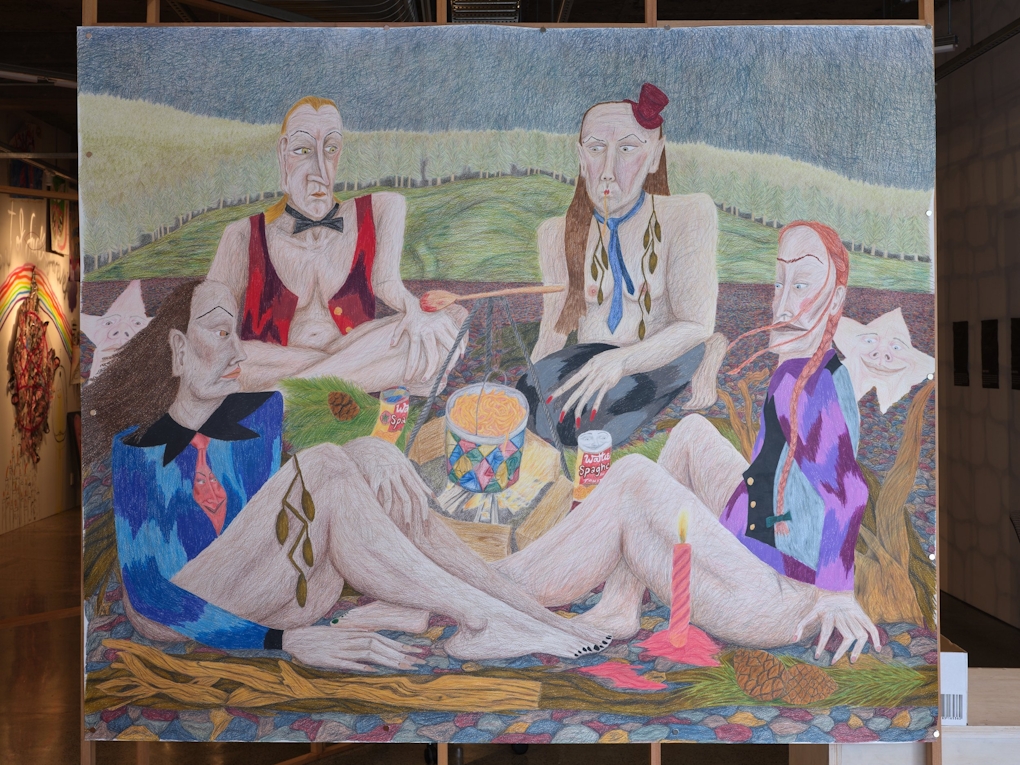
Beaks in the Stream (2021) Priscilla Rose Howe. Photo: Sam Hartnett
Bistro is a typically feverish Howe work in which similar figures are gathered round tables at the titular bistro enjoying various dishes, some enjoying each other as much as the fish or pasta. Nudity abounds here, bodies as succulently available as the food so that sexual and culinary fare are deliberately blurred. Between CONCUBINE’s harried wall-mural and the spidery polish of Howe’s renderings there’s a fabulous feedback, like the lines of each artist’s hands were shaking lustily, and perhaps still shake with unashamed cravings for abundant pleasures and emancipation, in equal measure.
Just as sprawling as CONCUBINE’s mural-work is Connor Fitzgerald’s film Towards the Sun (2021), a singular tracking of the elements set to a hypnotically ambient score—like the lush moment of epiphany in an indie coming-of-age movie, stretched out to a transporting, meditative, yet strangely succinct seventy-one minutes.
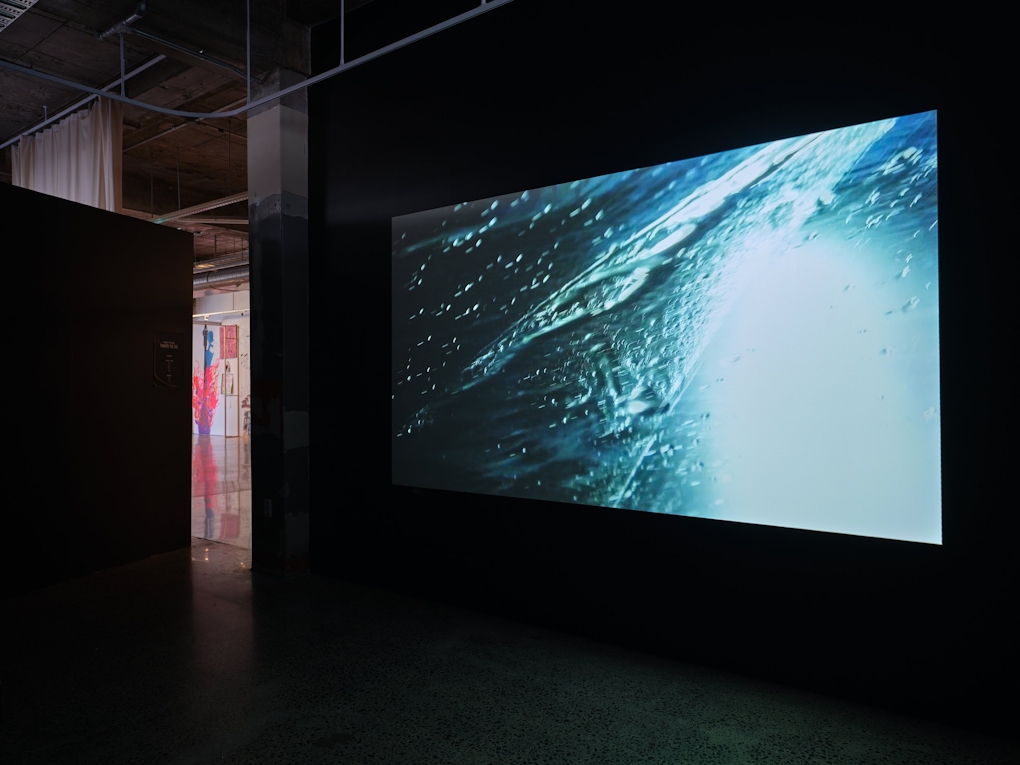
Installation view, Towards the Sun (2021) Connor Fitzgerald. Photo: Sam Hartnett
The film’s subject is essentially the generative elemental principles of life itself, as both the physical bedrock of neoliberal games, and also—in their culturally indifferent patterning—our relief therefrom. Nothing escapes the inexorable march of time or dilution via exposure to these impersonal, but no less beautiful, natural rhythms. We and our endeavours are as intractably ephemeral as the artist’s captured subjects, perhaps more so in the belligerent denial of our radical contingency with broader planetary metabolisms. As art films go Towards the Sun shares that trope of being pure visual affect, narratological elements mostly nonexistent outside recurring motifs of fire and ocean, heat and cold, light and dark. The point here is an oscillating ecological polarity, perhaps paralleling the same imperfectly dynamic tension within the show’s banner of cruelty and optimism—impulses which Fitzgerald’s work poetically illustrates holding space in the sometimes savage equilibriums of nature itself.
Connor Fitzgerald, Towards the Sun (excerpt), 2021
Finally, and it might seem strange rounding off this review with a work which greets you at the gallery door, is Ming Ranginui’s installation She lived allgoods ever after (2021). As Lauren Berlant made clear in her seminal work Cruel Optimism, the mythologising of upward mobility in viciously neoliberal environs is exactly that—myth, fairytale. Ranginui runs with the latter, in their work consisting of piled mattresses and a gown pointing with endearing whimsy towards The Princess and the Pea, that story of bourgeoise ennui so fragile, so delicate, that a pea-sized imperfection is felt through a layer cake of thousand-count bedding. Similarly, contemporary subjects navigating the fictitious (and infantilising) optimisms of our brutal meritocracy feel the inconsistency, have a nagging sense of wrongness in promises of endless wealth and comfort. Perhaps especially considering the social and ecological devastation twentieth and twenty-first century prosperity systems have left in their wake—and continue to leave as the ideological fairytale of limitless growth is adhered to with suicidal verve. Ranginui’s work, overtly pairing these ideologies with the pedagogical tool of fairytales—in as much as they classically functioned as morality-transmitters for children—points to that other fairytale in which a princess convalesces on a downy mattress befitting royalty: Sleeping Beauty. In this story a whole kingdom languishes in enchanted slumber awaiting a fevered kiss from Prince Charming, a consummation which could just as easily not happen considering its unlikeliness. We too, in the thrall of a dreamy capitalist mythos, commit to drudgery as somnambulists, sleep-walking through vague promises of ‘the good life’ and holding out for a Prince Charming who’s probably a no-show in the end. Bummer.
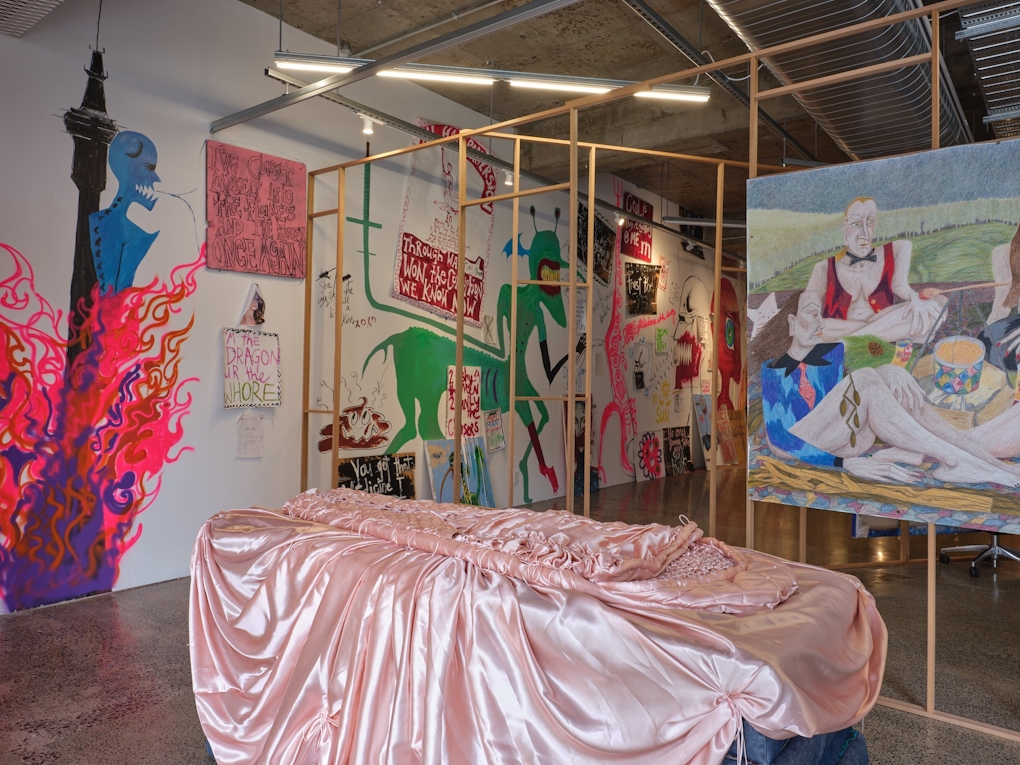
Installation view, She lived allgoods ever after (2021) Ming Ranginui. Photo: Sam Hartnett
That said, perhaps in the spirit of Halberstam’s Queer Art of Failure—a work of critical theory which dismantles the lure of normative success paradigms—this show, and the artists in it, demonstrate that a weirding, outside the expectations that a cruel or misplaced optimism might instill, can be infinitely more colourful, more gleefully deranged, and certainly more vital. It’s a message made doubly significant by the present pandemic related collapses, which are forcibly reconfiguring our expectations of ‘the good life’, and beggaring with our patience and stamina to look beyond the ruins.
Perhaps "optimism" is the wrong word now. "Endurance" comes to mind as a better descriptor of the moment’s requirements. Also "tenacity", "voraciousness", more bestial qualities by which I’m not prescribing a kitsch ersatz-activist violence, but more a transmuting of anxiety into the mettle to ask for more. Even when a surface appraisal might tell you the trough is irredeemably empty, CRUEL OPTIMISM is a charitable drop from a collection of up-and-coming water-bearers. In another word, this new artist showcase is unapologetically queer, and, in three more words, out for blood. Go see it. Because you can now.
